Donaldson Filters – Diesel Fuel Filter Kit
Donaldson Filters supply a diesel fuel filter kit, to protect modern common rail diesel engines from contamination.
Designed to be mounted on the chassis, this filter kit removes fine particles and water from your fuel before it reaches the engine. Common rail diesels demand clean fuel and simply won’t tolerate any contaminants.

We’ll be travelling to remote outback destinations, where the fuel quality sometimes leaves much to be desired. We decided an additional fine filter and water separator would be cheap insurance.
Why Is Contamination Such An Issue?
The days where diesel engines would tolerate just about anything you could throw at them are long gone. Modern common rail diesels run at incredibly high pressures and the injectors have high tolerances and fine orifices, 4 to 5 microns or less.
So it doesn’t take much imagination to realise a 30 micron filter won’t be much help in preventing injector blockages.
The other issue is the high pressures that common rail systems operate at. It’s not unusual for a system to run at 25,000 psi, with some of the larger truck engines running as high as 45,000 psi.
At these pressures, larger contaminants will be forced through the injector. They’ll split up and damage injector components as they are squeezed through.
The biggest issue however, is water.
Your Own Water Jet Cutter… In Your Engine
In industrial engineering, it is common to use what’s known as a water jet cutter to cut steel (and other materials) into shaped profiles.
Now a water jet cutter uses a fine jet of water mixed with fine abrasives to cut through steel up to 80mm thick. The water is pressurised up to 60,000 psi. At these pressures, a water jet cutter will cut through just about anything.
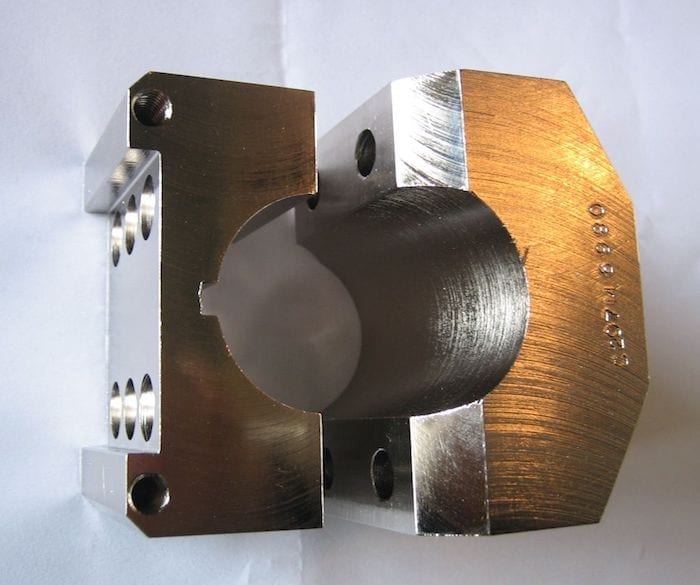
Can you see the similarities between a water jet cutter and your injectors? Just add water and contaminants to your fuel and you have a system that will destroy itself from within. The water acts as a cutting compound, damaging the injector’s components.
So Where Does The Water Come From?
One of the issues with buying fuel in remote areas is the possibility of water in the fuel.
Think of a fuel tank partially filled, sitting out in the desert somewhere. Even in winter, daytime temperatures can be in the mid to high 30s, while nights can get down to freezing. This is the perfect recipe for condensation.
And don’t forget your vehicle’s fuel tanks either. The same applies to these.
Or maybe the service station’s fuel tank is underground and water has leaked into the tank over time. It could be from a recent flood or a crack in the tank.
Worse still, the fuel might be a grade of biodiesel. Now biodiesel attracts moisture. While you should avoid biodiesel at all costs, sometimes it won’t be labelled and you won’t even know it’s biodiesel.
So what’s in this kit from Donaldson Filters?
A Complete Kit
Well, you get quite a bit:
- Two spin-on filters, rated at 3 microns. One is a spare.
- A filter head.
- Two straight brass barbs, sized for 3/8” fuel line.
- An optional clear bowl.
The filter head is cast aluminium and has two ¼” UNC tapped holes for mounting to a bracket.
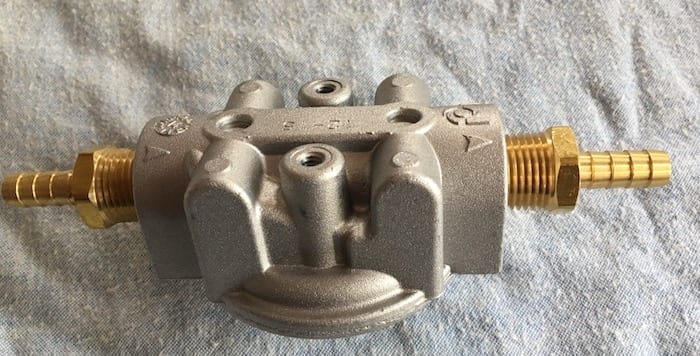
You don’t have to use the clear bowl, but it’s a really easy way to check if you have any water in the fuel. To install, simply unscrew the twist drain on the filter and screw the bowl in.

You’ll notice some black fuel line in the following photo. I bought this separately, with a packet of stainless steel hose clamps. Neither the hose nor the clamps are supplied with the kit. Just make sure the hose is rated for diesel usage.

This particular kit is rated to a maximum flow rate of 379 litres/hour. How do you know if this is adequate?
Checking The Kit Will Be Large Enough
It’s easy enough to check. We consistently get fuel economy of 18 to 18.5 litres/100km. Let’s assume worst case of 22 litres/100km, pushing into a headwind across the Nullarbor.
After one hour travelling at 100km/hour, we’ve used 22 litres. In other words, 22 litres/hour. However, additional fuel is continually pumped through the common rail system to cool the injectors. Up to 80% of the fuel pumped through, returns to the tank.
So our 22 litres/hour may only be 20% of the total fuel travelling through the fuel filter. Therefore, the total fuel flow rate is 22/0.2 = 110 litres/hour (where 0.2 represents 20%).
We’re at less than a third of the maximum rating of 379 litres/hour, so it’s okay.
Where Should You Mount The Kit?
It depends on your system. Ours is a little complicated. We have two fuel tanks, isolated from each other. Each tank has a 30 micron filter, then they come together at a switching solenoid valve. This solenoid valve is controlled by a switch on the dash. So we manually select which tank we draw fuel from.
The best way to explain this is by diagrams. From these, it’s pretty clear where the new Donaldson filter will be installed. Of course, the Isuzu has a fine filter and water trap mounted up near the engine. However, we figured it’s better to capture the contaminants and water before they get anywhere near this filter.
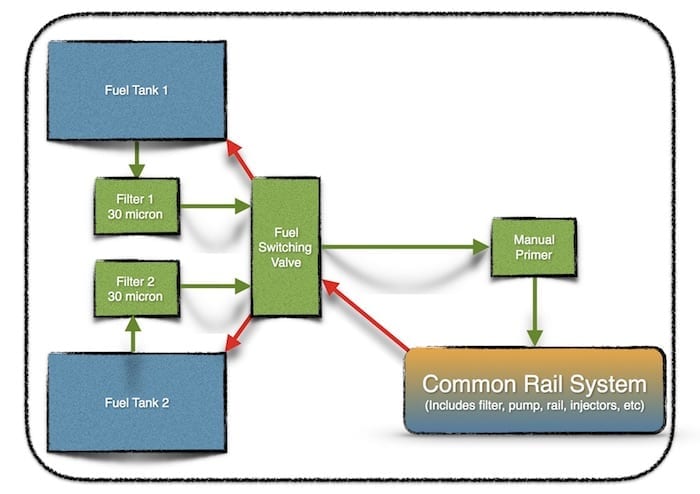
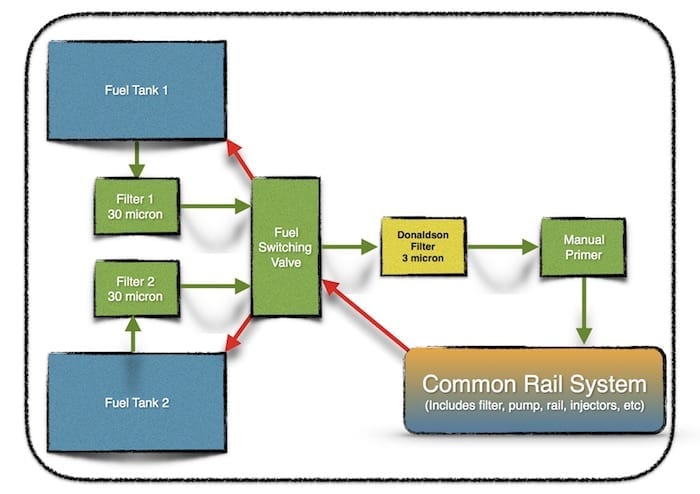
And finally, where are we going to physically mount the Donaldson filter kit?
To be honest, I’m not sure yet. We’ll attack this soon. We need to fabricate a mounting bracket, make sure we can see the bowl, can easily change the filter, then make a guard to protect the filter and bowl from any wayward stones.

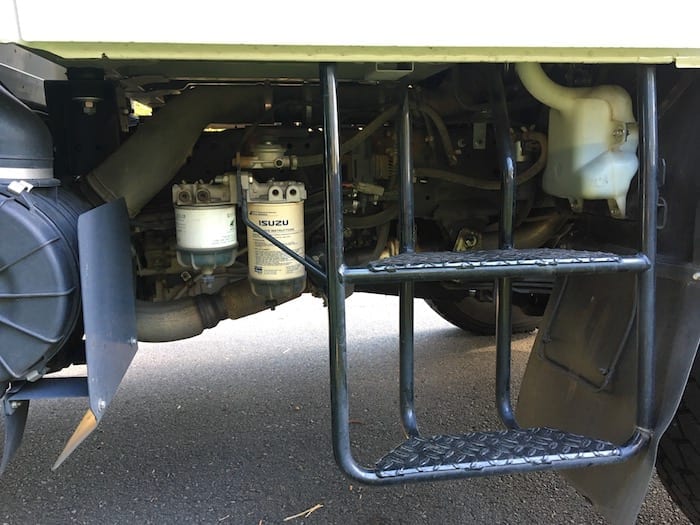

This is our next step. Go here to see where we finally mounted the filter kit.

Get your Traveller’s Guides
… and a whole lot more at our FREE RESOURCES Page!
Any questions or comments? Go to the Comments below or join us on Pinterest, Facebook or YouTube.
Any errors or omissions are mine alone.
NOTE: The Donaldson Fuel Filter Kit was supplied to us free, in return for a review. (That said, our reviews are always honest and authentic – we tell it how it is). Thanks to Brett Howe from Donaldson Australasia and Craig Kennedy from Dwyers Truck Centre, Nowra for organising this.
Looking for more reviews on 4×4 Accessories? Then go here for more.

Hi. Thx for running such a great site! Based on your review I has a Donaldson fuel/water separator fitted to my NPS truck. But a question: how often do you replace the filter?
Hi Trevor,
Thanks, it’s great to hear this site is helpful!
Regarding the filter replacement. Replace it at the same intervals as per the final filter (the one on top of the engine). The details should be in the truck’s service manual.
Cheers, Andrew
Hi Andrew, totally agree with you on having secondary filters. mine is a post filter of 2 microns – this is for what ever the factory one doesn’t pick up the post will. anything above 2-3microns as you mentioned, is abrasive and very quickly will kill injectors and pump, i have experienced. cheaper to have secondary filter. great insurance, thanks for you site. regards Gary
Hi Gary,
Yes, it’s definitely cheaper than a new set of injectors plus pump!
Cheers, Andrew